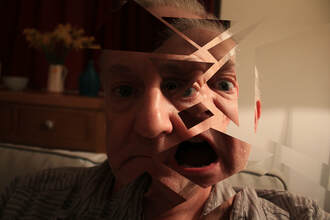Interview with Phil Smith
1. There’s always some sort of impulse in terms of finding the new topic. I know your work related to psychogeography. In your new book you touch topic of „the other”. How did it come to that?
I wrote a short essay about the movie ‘Quatermass 2’, scripted by Nigel Kneale from his TV series of that name. In the essay I suggested that this movie, along with some others, might constitute parts of a ‘canon’ of eco-eerie movies. The editor of the magazine (Undefined Boundary), Cormac Pentecost, asked me if I thought I could expand on that at book length for his Temporal Boundary Press, which I agreed to do. I have included some TV programmes also. These movies and TV are often addressed in terms of their inclusion of the supernatural (demons, ghosts, etc.) or their weird and eerie style, but very little has been done to assess their attention to ecological themes, implicitly or explicitly. So that is what I do in ‘Albion’s Eco-Eerie’.
2. What, in your opinion, is the state of hauntology in terms of tools and themes used now as opposed to what was it as a newly revived topic let’s say 20 years ago? In what form does it inhabit mass consciousness?
As an idea, hauntology seems to work now in different ways. For a few, there is Derrida’s original work in ‘Spectres of Marx’, for many more people it is a way into (or way of framing) feelings and ambience around certain artefacts from the 1960s and 1970s, often anticipating the failure of the reformist future, and how they have since been deployed in more recent art making (in films like ‘Kill List’, for example); this seems to have begun in music first with artists such as The Caretaker and Belbury Poly. Mark Fisher’s book ‘The Weird & The Eerie’ articulated some more approximate feelings towards these artefacts, and contextualised them (partly through other work, like his ‘Capitalist Realism’) as part of a pushing back at the disappointment of post-war utopian-reformism. More recently, one might expect the hauntological to decline into something more exclusively stylistic or commodified, but it remains more resiliently resistant than that. It is somewhat quietist, but it fits a moment when there is no obvious way to the future.
3. Why does this obsession with “the other” has even political implications?
Perhaps because ‘the other’ is now the key component of right wing politics. In the past the democratic right might look to national pride, religious-based moral rectitude or free enterprise, but now – in the context of the entire right’s pessimism – they can only look to the negative and offload that onto someone else: that is, the ‘other’. I think this might explain how many right wingers these days would fit an ‘other’ designation by, say, white supremacists, and yet persist in ‘othering’ others, as if the process can be contained and directed. That, within the right wing, there are ‘our others’, and ‘the other others’. This is a wholly human-centric process. At the same time there is a positive possibility for attention to unhuman others, not as victims of humans, not as destructive villains, but as co-agents in a suffering/transforming eco-system. In the book, I am suggesting that we stop regarding these unhuman others as problems to be ‘solved’/eradicated, but either as allies to walk alongside or as ‘demons’ to be respected and (mostly) left alone.
4. In what way does or doesn’t the topics of (folk) and (hauntological) horror can be useful in individuating your Self or even to have healing properties if at all?
In the attention to space that some of these ‘folk horror’ or ‘hauntological’ artefacts encourage. This relates to Mark Fisher’s attention to the outside as crucial to their strangeness. If we attend to our selves in relation to an outside, to the spaces we can tend, to those edgelands full of the promise of theatre, to the enclaves of accidental re-wilding in the city, then we can create a self outside ourselves. That is quite a weird idea, but very healthy, I think.
5. In the times of panic and disorder how does cryptozoology and anything related to otherworldly species have any role in popular culture and anything outside of pure “entertainment “?
It will be difficult to peel Bigfoot and werewolves from generic entertainment. Fisher writes of how vampires and werewolves are hardly weird anymore given how codified they have become. Nevertheless, I think there may be a role for them – in tune with cryptozoologist Richard Freeman’s recent book ‘The Highest Strangeness’ – in our coming to understand many experiences and many entities as straddling the physical and the numinous. That there is an uncertainty in reality and an unevenness in the cosmos itself, which should make us, as a species, far more tentative and wary about doing anything. We should start from assuming that there are no solutions, but that there are only reconciliations.
6. How would you place your current research in the landscape of psychogepgraphical odyssey?
Somewhere to the side. I never felt I belonged, and I think that is a good place to be right now; to look like you do, but feel like you don’t, and use the friction. My interests are many, but I have recently prioritised attention to those unhuman others (from jellyfish to demons) who seem to want to play a part in our futures, despite the catastrophic prospects.
7. Are you working on any new topic at the moment?
Yes, two new books with my Crab & Bee colleague, the visual artist Helen Billinghurst; one for Peakrill Press on ‘the old stories’ and another on diagrammatical performances for Routledge.



Comments
Post a Comment